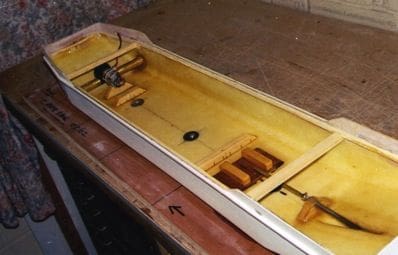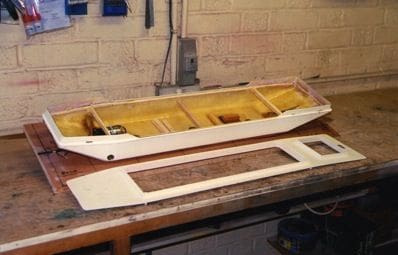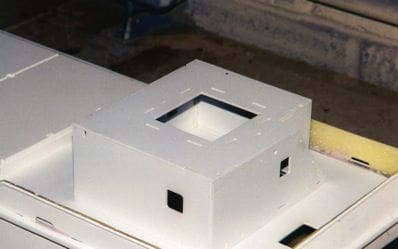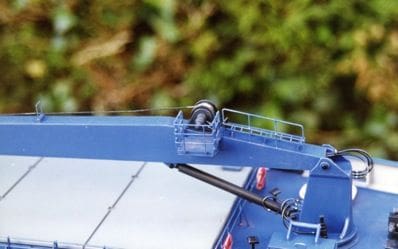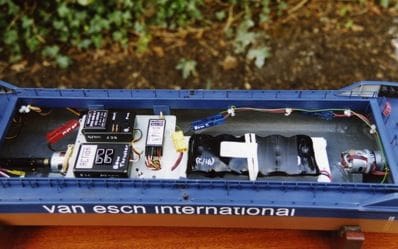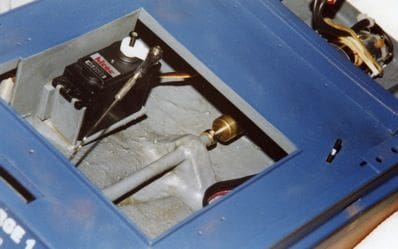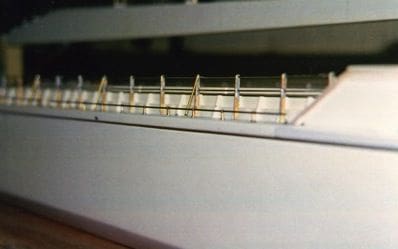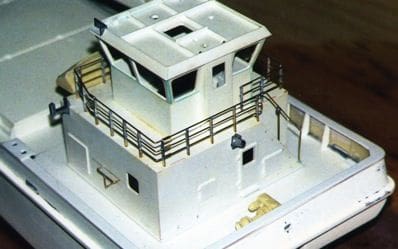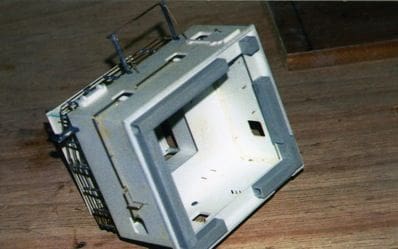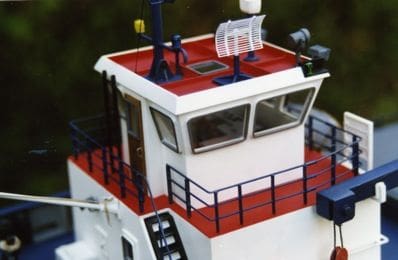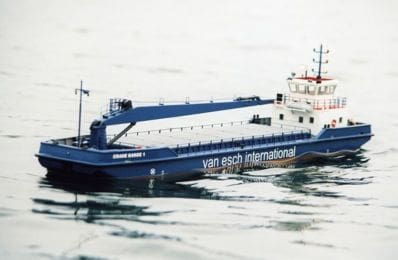DAVE BRUMSTEAD with a regular look at the scale scene
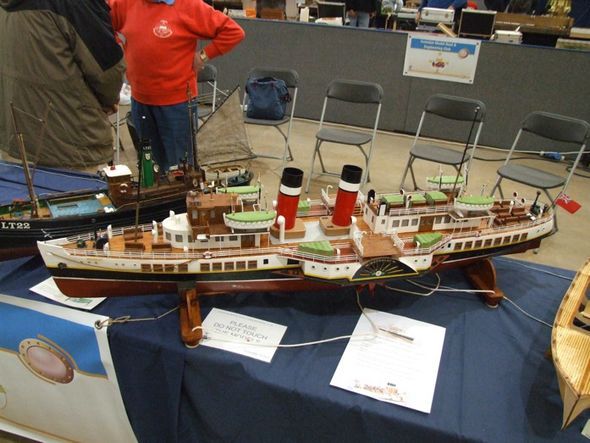
Photo 1
Welcome to this month’s Focus on Scale. This issue we are making our first visit to the South West Model Engineering, Model Making and Hobbies Exhibition at the Royal Bath and West Showground, Shepton Mallet, Somerset and looking back at a short review of the Sievers Crane Barge.
The South West Model Engineering, Model Making and Hobbies Exhibition
Enjoy more Model Boats Magazine reading in the monthly magazine.
Click here to subscribe & save.
This was our first visit to this show which actually started for the first time last year. We were there with the MyHobbyStore trailer, so we arrived the day before the show was open to the public. The showground is normally used for agricultural shows so there was plenty of room inside and out for the model activities which included flying, r/c cars, tanks and lorries as well as boats. There was also a large trade presence which we were told had increased since last year.
The clubs
The majority of the clubs were inside in either the Showering Pavilion or the Mendip Hall. The first club we encountered was the Swindon Model Boat and Engineering Club and the model which caught our eye was that of the Waverley, Photo 1. Built by Brian Mortimer, the model is described as a 1:48 scale ‘stand-off’ model. A single 600 size electric motor provides the drive via a Qualcast lawnmower toothed belt and pulleys. Two 6v SLA batteries wired in series to give 12v provide the power. The model also has on board lighting and a sound system. The full size vessel has a 2100 horsepower triple expansion steam engine driving the two eighteen foot diameter feathering paddle wheels.
Nearby was the Stirling Engine Society with a range of hot air engines being demonstrated. What attracted our attention was a rather sorry looking boat on one side of the stand. This model featured a Kitchen rudder, something not commonly seen, Photo 2. When the two plates are in the open position the thrust from the propeller is unimpeded and the boat moves forward. If the two plates are closed together behind the propeller, the wash is deflected towards the front of the boat, moving it astern, so this enables a non-reversing motor to be used. The two plates share a common pivot point so that they may be turned from port to starboard to control direction as well. Photo 3 shows the operating servos; the smaller blue servo controlling the opening and closing of the plates giving forward and reverse, and the black servo on the right with the extended arm controlling directional port and starboard movement. With this type of rudder and drive arrangement it is also possible to move the plates into a neutral position, where the model remains motionless in the water with forward thrust and reverse thrust being equal. Originally known as ‘Kitchen’s Patent Reversing Rudders’, the system was patented by Admiral Jack Kitchen in 1916.
At the entrance to the Mendip Hall, the Steamboat Association of Great Britain had the superb Lady May on display, Photo 4. Built in 1928, double skinned with Western Red Cedar planking on steamed Canadian Rock Elm timber frames, the Lady May is 25ft. 9ins long with a beam of 6ft. Originally built with a petrol engine, the boat is now powered by a two cylinder compound Savery steam engine built in 1912 and the boiler is a Lune Valley style built by Morgan Giles of Teignmouth in 1968.
The Lady May was originally built by Camper and Nicholson of Gosport as a yacht’s tender. There was a General Arrangement drawing stuck on the side of the hull, Photo 5, which provided useful background information.
Next door to the Lady May was the Tone Valley Model Boat Club. This club sails in Vivary Park, Taunton and their contact is Eddie Grant, tel: 01813 283077. These two fine models, Photo 6, were amongst many on their stand. Both were built by H.J. Grabham of Chard. The model on the left is a Caldercraft Northlight, and the other a Billings kit model of the S.T. Canute, the full size version of which used to be in Exeter’s Maritime Museum.
Shepton Mallet Drifters, being the ‘home club’ had one of the larger stands, Photo 7, with a comprehensive range of model boats. There were static display models as well as operational models that made use of the outside pool.
Regular attendees at the Alfold Show and enthusiastic fund raisers for the RNLI, the Southern Model Lifeboat Society had brought along a selection of their models, as well as collection boxes, Photo 8. We will see them again at Alfold this year when the Saturday (May 30th) will also be their 21st anniversary. From left to right the models displayed are Rother Class, Waveney Class, Tyne Class and Arun Class lifeboats.
The City of Plymouth MBC also had an impressive array of models on display. The tug Canning was made by Ron Fry, scratch built on a commercial hull to a scale of 1:32, Photo 9. The full size vessel was built in 1954 as an oil burning steam tug for Alexandra Towing Co. Ltd. After working in Liverpool until 1966, Canning was transferred to Swansea where in 1974 she was acquired by the Swansea Maritime museum for preservation. This model is also steam powered, Photo 10, using a Cheddar Gemini Twin cylinder steam engine fired by L. P. gas.
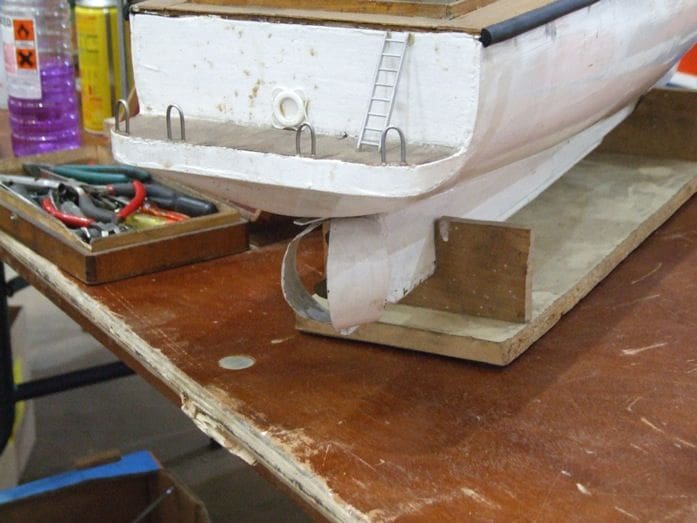
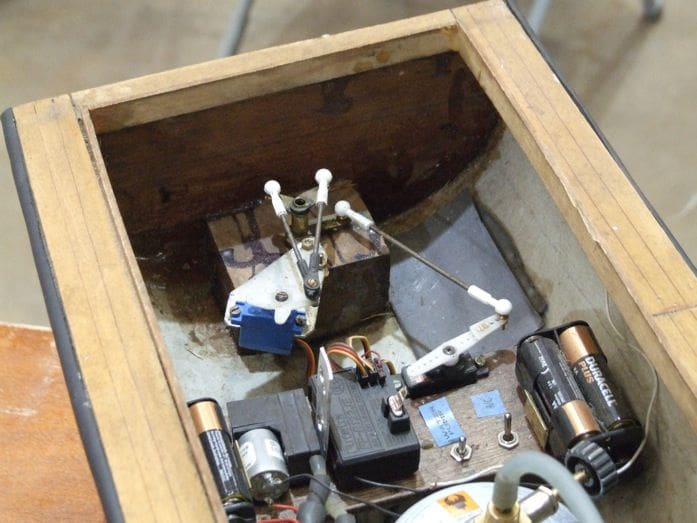
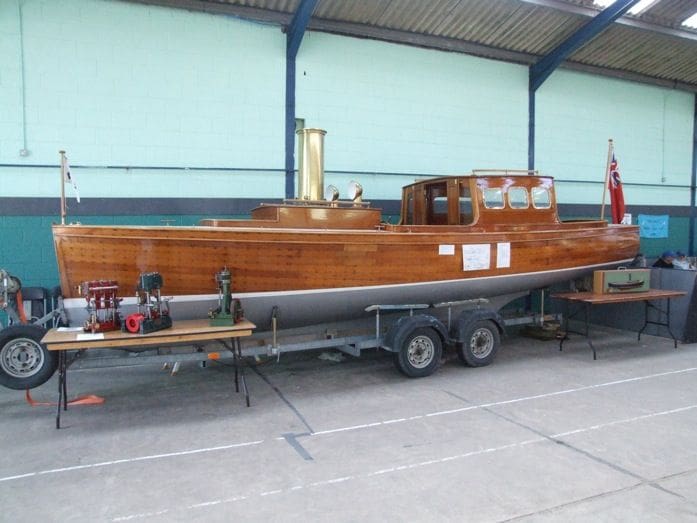
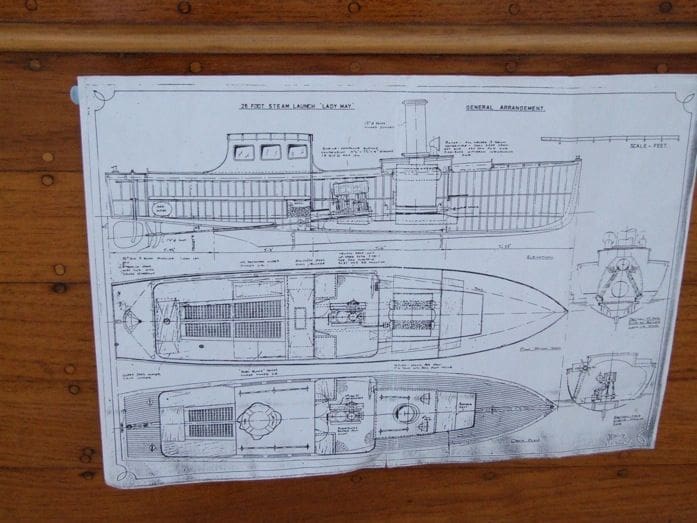
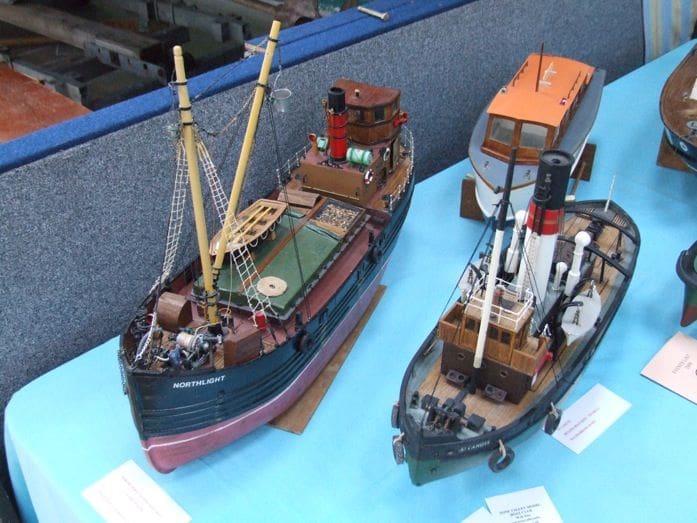
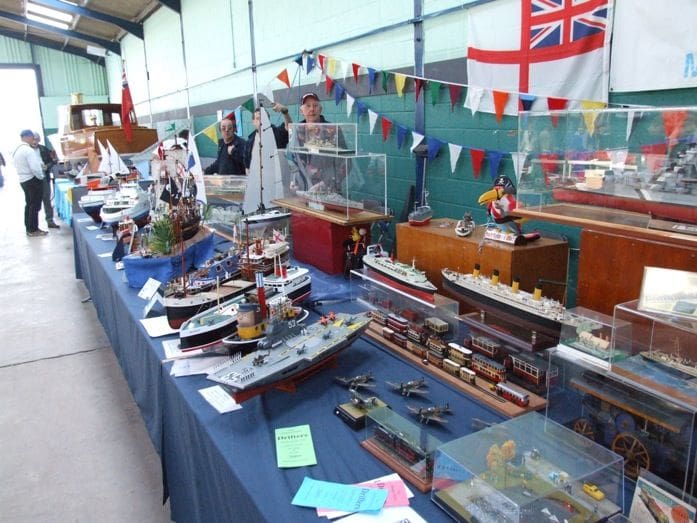
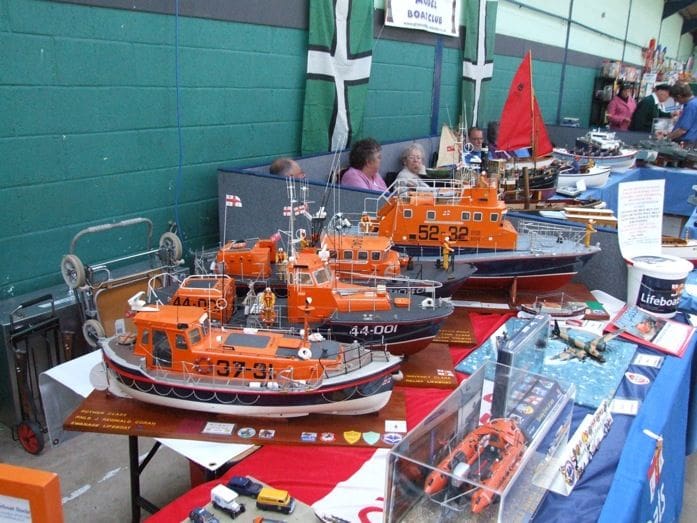
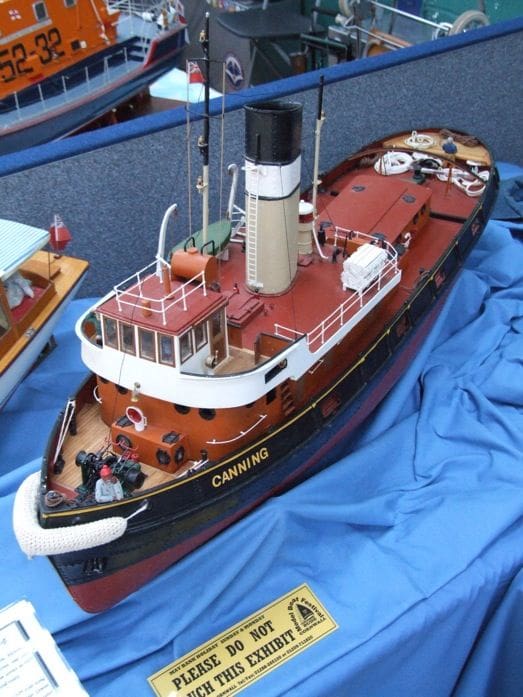
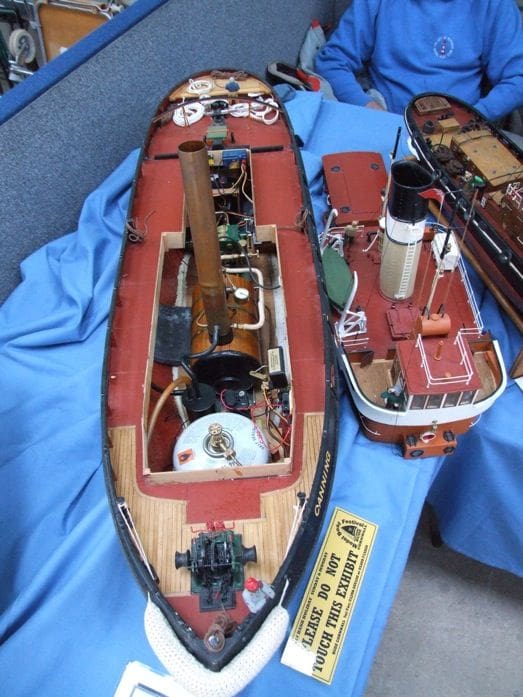
There were also plenty of ‘Grey Jobs’ on display for the warship enthusiast. As well as the Surface Warship Association in attendance, the Yeovil Model Warship Association also had a display of their models, Photo 11. Despite the club’s name, they are keen to point out that they welcome all types of model boats. Their home water is a lake behind the Halfway House Inn and County Lodge on the A37 between Yeovil and Ilchester, South Somerset. Seems a bit of a coincidence finding a sailing water behind a pub. We must try and get ours changed! The club sails Thursday afternoon and all day Sunday each week. Rob Walker, the Chairman, can be contacted on tel: 01935 421918 for membership and visiting inquiries.
We met an old friend of ours, Les Trathen, from the Brean Modelmakers Week. He is a founder member of the Hayle Model Boat Club. Les had his model of Diana, a 1:12 scale freelance model of a local fishing boat on display, Photo 12. His notes state that the model is radio controlled with propulsion from a radiator fan motor from a Renault car. The weathering is natural as the model hasn’t been repainted since it was built in 1973! The model has crossed the bay from Hayle to St. Ives twice on sponsored runs in aid of the RNLI.
Photo 13 shows a small part of the Cheddar Steam Club’s stand. Based in Cheddar, Somerset, this club uses the facilities originally used by Cheddar Models Ltd. to test their steam boat engines. After the company stopped trading the club was lucky enough to get permission to use the lake which is about 50 metres in diameter with a maximum depth of 1.5 metres. The also has a railway layout suitable for 32mm and 45mm gauge locos. The club chairman Eric Fosbury, can be contacted on tel: 01373 465684 for more information.
The final club stand we looked at before moving on to the trade support, was that of the Cwmbran Modelling Society. On their stand was this model of an American 44ft Motor Lifeboat, MLB 44347, Photo 14. The model, by Ralph Davies, is built from a Billings kit. A quick check on the Billings website shows that this version is no longer listed, but a 1:40th scale model kit is available. If you prefer something larger, Models By Design have the RNLB Waveney Class ‘The Scout’ at 1:15 scale, producing a model that is 36 inches long and of course Metcalf Mouldings sell a 1:12 scale full kit. The Waveney Class was based on the 44ft. MLB. Coincidentally, the last American Coastguard 44ft MLB has been retired and decommissioned on 8th May this year, the class of vessel having been in service for 46 years.
Whilst at the show we ‘acquired’ the newly printed ‘SWAMBC 2009 Essential Guide to Model Boating in the South West’ including club details, diary dates and competitions, etc., courtesy of Mike Knight.
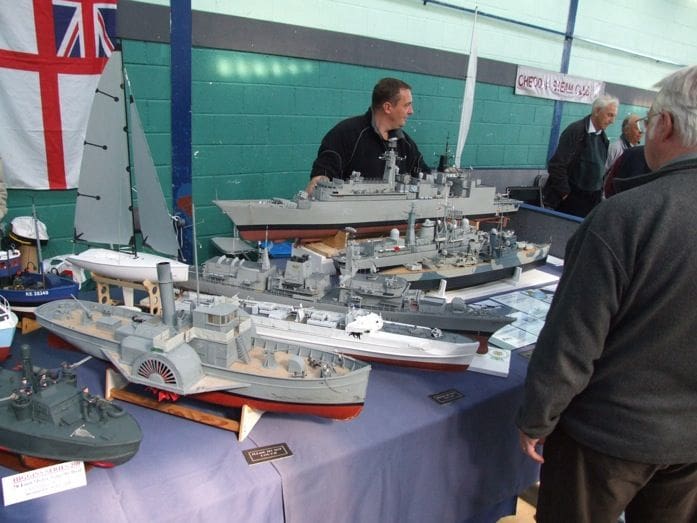
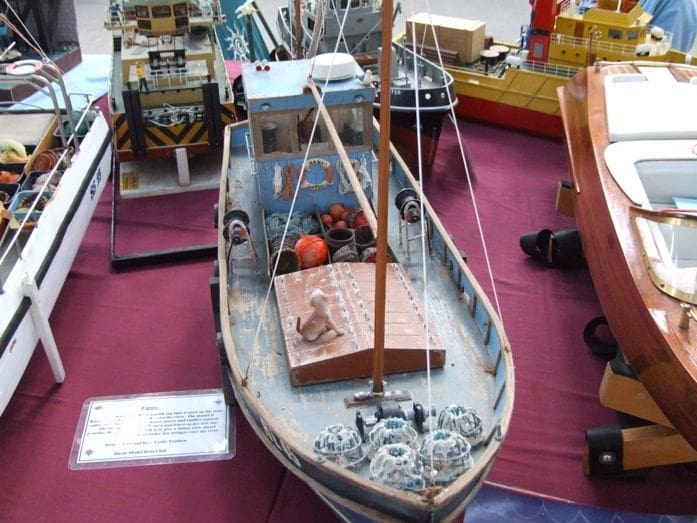
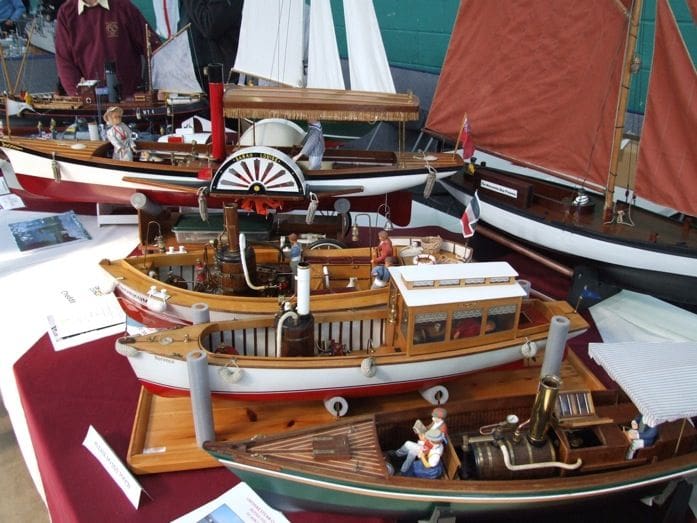
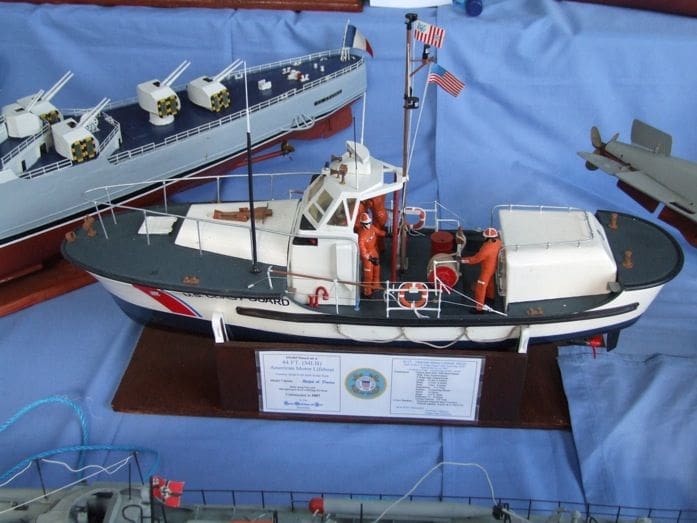
Trade
There was a strong trade presence at the show covering most model maker’s requirements. Photo 15 shows Graham Shepherd of Hunter Systems with his range of electrical bits and pieces with regular show attendee ModelPower next to him. A relative newcomer to us was Component Shop, who had a range of batteries, chargers, cables and LEDs, Photo 16.
Another regular was ACTion in the form of Dave and Liz Milbourn, who had their range of electronic switches, speed controllers, mixers, sound effects and distribution boards amongst their products for sale. Many of these units could be tried out on their demonstration rig, Photo 17.
The final trader that we’ll mention is Marks Model Bits. This company have produced a Smoke Generator using ordinary tap water. There are two basic units available, small and large. The only difference, apart from size, seems to be the running times on one fill of water. The large unit will run for one hour and the small unit for 40 minutes. These units retail for £45 each. There is another unit available that incorporates a speed controller. Photo 18 shows the unit in action and more details should be found on the MMB website: www.marksmodelbits.com or tel: 01633 431010.
Well, that’s all from the South West Model Engineering, Model Making and Hobbies Exhibition.
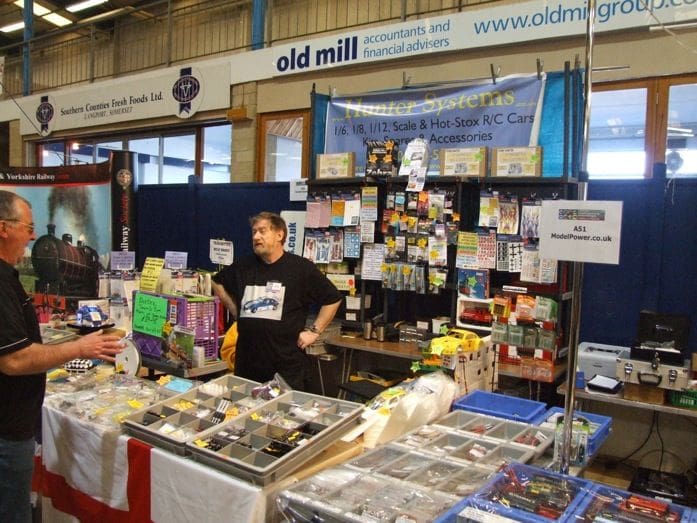
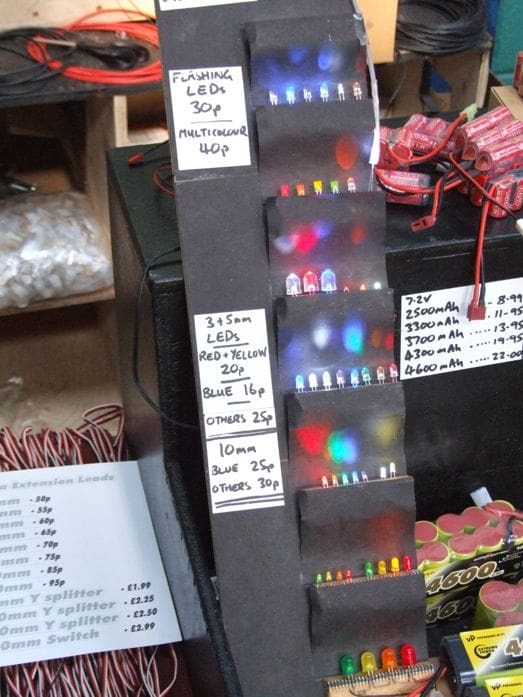
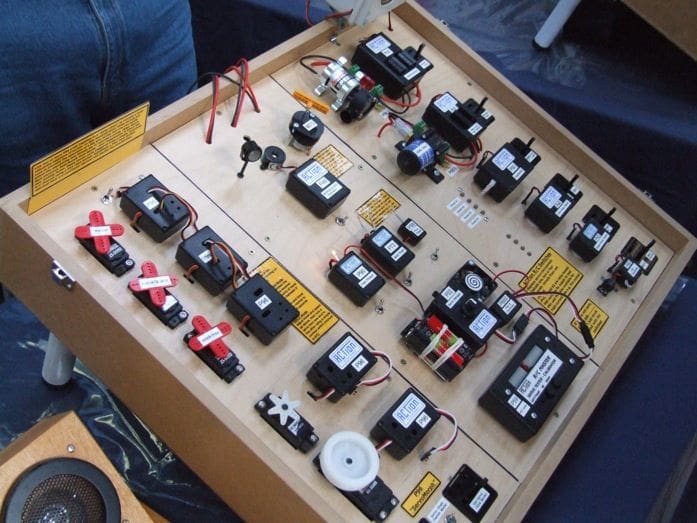
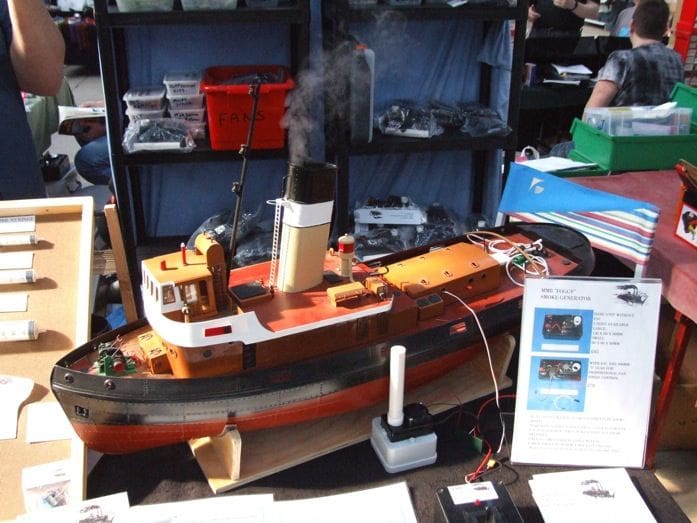
Crane Barge kit review revisited
This issue we look back to a kit review that was featured in ‘Focus on Scale’ from January to August 2003. Column co-writer at that time, Paul Freshney (your Editor), had purchased the ‘Crane Barge 1’ from Modellbau Sievers in Germany and covered the build in that period after a pre-amble in the June 2002 magazine. Why the delay? Well he moved house in June 2002 and had a three month gap on modelmaking as a result.
The kit, packed in a strong cardboard box, contained a GRP hull, full size plan, precut styrene parts, resin fittings, brass etches, rub-down transfers, propshaft, rudder, injection moulded wheelhouse window frames and a pre-drilled deck for the stanchions. Paul made the point that there is no cutting or drilling required on the styrene parts. The model to a scale of 1:50, has an overall length of 804mm and 205mm beam.
Construction began with securing the flat bottomed hull to the building board and fitting the deck edge supports after the bulwarks had been smoothed off with car body filler. A Graupner bow thruster was also installed followed by the main drive, Photo 19. The deck was prepared by joining the two sections together and reinforcing the joint. With the hatch coamings in place the deck was glued in place with 24 hour epoxy adhesive. Photo 20 shows the deck ready for fitting. The plastic propeller and rudder were substituted by commercial metal versions.
The basic superstructure was assembled next. The various parts are slot and tab connected and can only fit together one way, Photo 21. Any gaps on the slots and tabs were filled with fibreglass car body filler.
The crane, the main feature of the model, was now assembled, with the basic kit unit being enhanced by the addition of hydraulic hoses and fittings. This in its completed form is in Photo 22.
The next major step was to install the radio control equipment, Photo 23.The main drive motor, a 385 size unit, can be seen to the left of the picture. Next to this is the main motor ESC and the bow thruster ESC, the generic 40MHz Webra receiver, main drive NiCd pack and finally the motor of the bow thruster. The rudder servo was also installed, ensuring it was positioned to give sufficient rudder deflection, Photo 24.
The various railings were made up next, Photo 25, and those around the superstructure were left detachable until the wheelhouse had been painted, Photo 26. The base of the superstructure was modified by the addition of square section plastic set inside and below the bottom edge to make for a better fit over the coaming which at 5mm height offered minimal support to the superstructure. The additional square section that fitted inside the deck coaming would also help to stop the ingress of water, Photo 27.
The next step was to prepare and paint the hull. Etch primer (often used by railway modellers) was used on all the brass components to provide a good key for the paint, then the usual Halford’s aerosol primer followed by an overall airbrushed finish. This is in turn was sprayed with Ronseal satin varnish to give an ‘even’ finish to the model. The various supplied lettering was now applied to the hull plus the depth markings and whole model weathering, then followed by further applications of thinned varnish (Ronseal again, thinned 1:4) to seal and protect everything. The wheelhouse was also prepared for painting and once complete the various fittings were added, Photo 28.
The last task was the sea trials, Photo 29. Paul stated that the model sailed well and stayed dry. It was however absolutely lousy when going astern!
When the kit was purchased in 2002, the cost was 197.40 euros plus p&p of 10 euros. At that time this equated to about £140. The current price, from the website at www.modellbau-sievers.de is still just 209.25 euros, but with the present UK pound to euro exchange rate (April 09) this equates to approx. £186 + p&p or approx. £200 in total, but this is still good value in current kit terms.
That’s all for this month, happy modelling! If you want to get in touch please do so either via the Editor, or email: [email protected].
